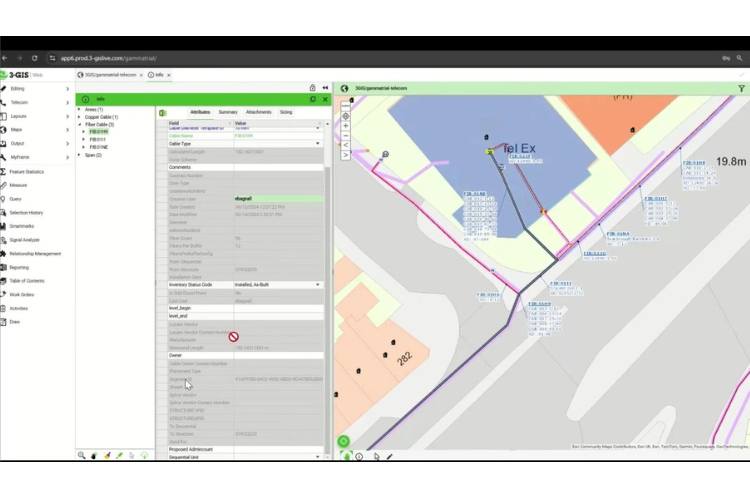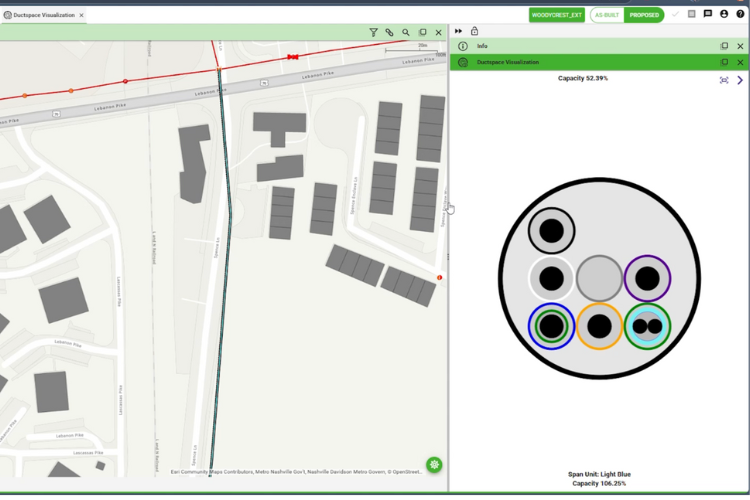With the surge in fibre network rollouts, the demands on network management solutions are greater than ever. Yet, many telcos are still navigating the complexities of managing their operations without a solid, scalable physical network inventory (PNI) solution at the heart of their infrastructure.
If your team is experiencing slow performance, mounting inefficiencies, or unexpected downtime, your current physical network inventory (PNI) system may be holding you back. In this blog, we’ll discuss the risks of an inflexible PNI, the key components of an effective system, and how to future-proof your network for long-term success.
The core of a scalable network
A robust PNI solution serves as the backbone of a telecom operator's network management. It’s more than just a database; it’s the system that enables telcos to efficiently plan, design, manage, and monitor their fibre networks. It accounts for every physical asset—ducts, cables, manholes, splice closures, and equipment—alongside critical connectivity records that enable accurate tracing from the exchange to the customer.
A truly scalable PNI solution needs to support:
- Complex data sets: Networks with millions of spans, cables, and equipment require a well-structured, high-performance data model.
- Efficient usability: A cluttered or outdated system can slow down operations, causing frustration among engineers and operational teams.
- High performance: The ability to process large-scale network modifications and new connections without system slowdowns
- Seamless integration: Compatibility with GIS, network planning tools, and automation processes to support operational agility
The risks of ignoring scalability in PNI
Whilst it may be tempting to chase feature-rich solutions, the real question is: how well will these systems scale as the network grows? Here are some of the key risks of neglecting scalability in a PNI solution:
1. Data congestion and poor visualisation
As a network grows to include millions of fibres, sub-ducts, and splice points, a poorly structured system can lead to confusion and inefficiencies. Overloaded maps with offset cables create usability nightmares, making it nearly impossible for engineers to efficiently trace fibre paths and make necessary modifications.
2. System bottlenecks and downtime
Many network inventory solutions impose limitations on daily processing, creating a backlog of work orders. For example, if a system can only process 1,500 orders daily but the demand requires 2,000, a telco could quickly face operational disruptions. If the system isn’t built to handle rapid growth, it can cripple a telco’s ability to meet demand.
3. Costly and time-consuming upgrades
A ‘grow as you go’ approach may seem logical, but it often results in expensive, complex migrations as telcos outgrow their initial solution. A well-structured PNI solution should be designed with future growth in mind, preventing the need for costly overhauls down the road.
4. Security and compliance vulnerabilities
No matter the size of your network, data security and compliance are critical. Some telcos operate in multiple regions where data access restrictions apply, requiring a solution that can mask sensitive information from unauthorised users. Failure to implement robust security controls can result in regulatory violations and data breaches.
5. Challenges with automation and future technologies
Automation is becoming a necessity for telcos aiming to optimise operations and customer service. However, an overcomplicated or inefficient PNI can hinder automation efforts, leading to increased manual intervention and operational inefficiencies.
Testing for scalability
One of the biggest pitfalls telcos fall into is failing to test the scalability of their PNI solution before fully implementing it. A proper non-functional test cycle should simulate:
- The full volume of expected data (millions of records including cables, ducts, and connections)
- The maximum number of concurrent users making edits
- The required daily transaction loads
Without this, telcos risk implementing a system that fails under real-world conditions, leading to costly and time-consuming fixes.
Making security a priority
For telcos managing large networks, security should never be an afterthought. A scalable PNI must include role-based access controls and row-level security to prevent unauthorized data access. This ensures that offshore teams or third-party contractors only see the data they are permitted to access, reducing security risks.
Opensource solutions: Weighing the trade-offs
Some telcos are drawn to opensource solutions to avoid licensing costs, but these systems come with hidden risks. Opensource software often requires ongoing penetration testing to detect vulnerabilities, and support can be inconsistent. While it may seem cost-effective initially, the long-term investment in security and maintenance often outweighs the savings.
Future-proofing your physical network inventory
Telcos today can’t afford to prioritise short-term functionality over long-term scalability. A scalable PNI is not just an operational tool; it is the foundation of efficient, high-performing, and future-ready network management. Operators must ask themselves:
- Is my current PNI solution scalable for the next five years?
- How does my system handle large-scale data visualisation and edits?
- Can I integrate automation seamlessly without running into issues?
- Am I meeting security and compliance requirements across different regions?
By selecting a PNI solution that is designed for growth, usability, performance, and security, telcos can ensure they are building solid foundations for the future. Are you confident that your current network inventory solution can scale up and meet the demands of expansion? If not, it may be time to reconsider your approach.
This blog post is based on the recent webinar Chasing features or building foundations? The key to network scalability. Watch on demand here.



